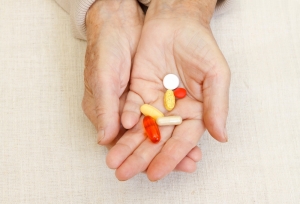It used to be said until recently that no Alzheimer’s treatment would show convincing evidence of reversal of the process that leads to Alzheimer’s disease.
However, even a lack of further progression or slowing down of the progression was considered progress. Ref. 9 reviews some of the trials regarding Alzheimer’s therapy that have changed the landscape of treatment of Alzheimer’s disease.
Since then more research has taken place and low dose estrogen replacement therapy in postmenopausal women that used to be thought of being the most impressive therapy is now frowned upon by most physicians.
The risk of strokes, heart attacks and uterine cancer outweighs the benefit that had been proven with regard to Alzheimer’s. Estrogen therapy has now been replaced by other therapies that work by clamping down the production of the beta-amyloid. The first such newer effective medication, donepezil (brand name: Aricept), which is a cholinesterase inhibitor, can improve memory loss at least temporarily at the early stage. There are some drug interactions and side-effects, but the doctor can decide whether or not this should be used. At a recent conference in Vancouver/BC (Ref. 16) Dr. Howard Feldman who is involved in several clinical trials involving newer treatments for Alzheimer patients reviewed the beneficial effects of a combination of Memantine, yet another anti-Alzheimer’s drug, and Donepezil. This combination reduces or eliminates the earlier inflammation phase of Alzheimer’s and prevents the neurodegenerative phase from taking place, which is irreversible and leads to permanent memory loss. Cholesterol lowering drugs (like the statins etc.) are another newer way to cut down on plaque formation, secretase inhibitors are another way. The neurologist who treats the Alzheimer’s patient will have more detailed information for you.
What are some of the other more natural ways to treat Alzheimer’s?
Vit. E is a well known antioxidant vitamin, which helps to protect the brain lipoproteins from being oxidized further. Ginkgo biloba comes as an extract called EGb, which is said to slow down such symptoms as memory loss and some other symptoms of Alzheimer’s by functioning as a free radical scavenger. However, these two supplements may not be as powerful as some of the claims that are made for it.
This and the non steroidal anti inflammatory drugs (=NSAIDs) have been further evaluated. NSAIDs are prostaglandin inhibitors and they were hoped to keep the inflammatory response to the amyloid in the brain under control. However, some of these trials are negative, others only borderline positive, so presently this was listed under “not so hot” by the Alzheimer’s researcher Dr. Howard Feldman at the conference in November of 2004 (Ref.16). The reason may be that cholesterol is at the beginning of the biochemical synthesis pathways of the sex hormones that are essential for preservation of the brain metabolism. Newer insights regarding this come from the antiaging branch of medicine as summarized under this link.
Otherwise, coexisting depression needs to be treated , not with tricyclic antidepressants (these have anticholinergic side effects making symptoms worse), but with the newer SSRI antidepressants.
As always in medicine, prevention is key, but this message does not get promoted enough. Weight loss, exercise and eating of nuts and other omega-3-containing foods will prevent Alzheimer’s. Magnesium supplementation is also an important measure to prevent the formation of plaques.
Bioidentical hormone replacement has also been shown to prevent Alzheimer’s, when given early enough.
Detoxification is also a powerful preventative against developing Alzheimer’s disease.
Detoxification
Books like “Breakthrough” (Ref.17) by Suzanne Somers have reviewed newer insights of antiaging medicine. This points out the importance of detoxifying the body from heavy metals like mercury, lead and cadmium. Particularly mercury from amalgam tooth fillings are thought to have a close relationship to the risk of developing Alzheimer’s disease. Some anti-aging physicians recommend intravenous chelation therapy to remove such toxins.
References:
1. OL Lopez et al. Neurology 2000 Dec 55(12):1863-1869.
2. K Yasojima et al. Brain Res 2000 DEC 887(1):80-89.
3. A Kontush et al. FreeRadicBiol Med2001Jan30(1): 119-128.
4. H Vanderstichele et al. Amyloid 2000Dec7(4):245-258.
5. Neely et al. Lipids 2000 Nov35(11):1249-1257.
6. RA Yokel Neurotoxicology 2000 Oct21(5):813-828.
7. Petanceska et al. Exp Gerontol 2000 Dec 35 (9-10):1317-1325.
8. MB Liddell et al. Brit J Psychiatry 2001 Jan 178: 7-11.
9. Sramek et al.ExpertOpinInvestigDrugs2000Apr9(4):899-915.
10.K Kosaka et al. Neuropathology 2000 March 20(1): 1-7.
11.V Haroutunian et al.Arch Neurol 2000 Aug57(8):1145-1150.
12. C Puckett et al. Am J Hum Genet 1991Aug49(2):320-329.
13. M Haltia Ann Med 2000 Oct 32(7): 439-500.
14. Ferri: Ferri’s Clinical Advisor: Instant Diagnosis and Treatment, 2004 ed., Copyright © 2004 Mosby, Inc.
15. Rakel: Conn’s Current Therapy 2004, 56th ed., Copyright © 2004 Elsevier
16. The 50th Annual St. Paul’s Hospital Continuing Medical Education Conference for Primary Physicians, Nov. 16 – 19, 2004
17. Suzanne Somers: “Breakthrough” Eight Steps to Wellness– Life-altering Secrets from Today’s Cutting-edge Doctors”, Crown Publishers, 2008







